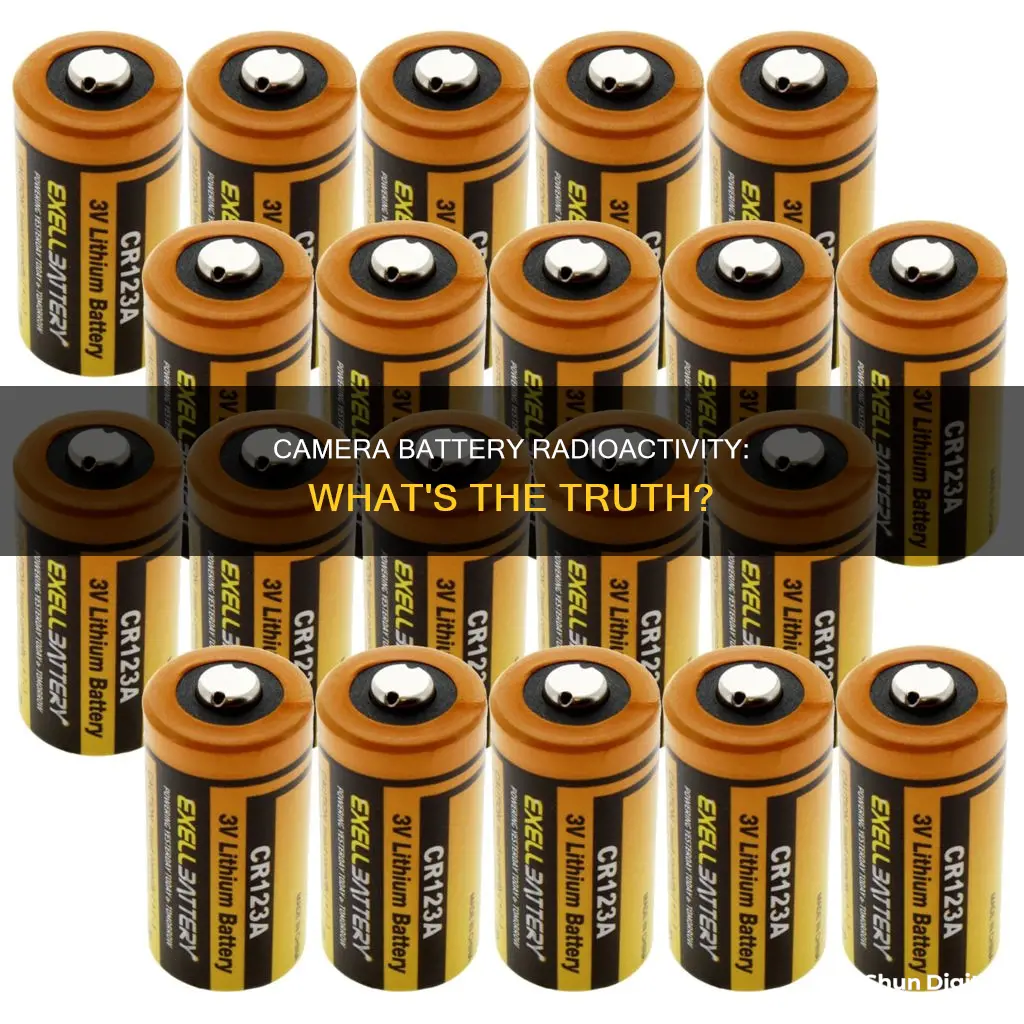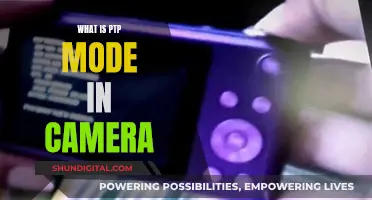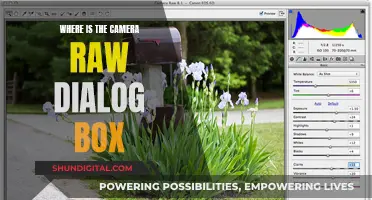
Cameras can be used to detect radiation, but are camera batteries themselves radioactive?
The simple answer is no. Camera batteries are not radioactive. However, there is ongoing research into the development of radioactive diamond batteries, which could potentially power cameras in the future. These batteries are designed to last for thousands of years without needing to be charged or replaced and work by collecting particles emitted by radioactive diamonds.
While standard camera batteries are not radioactive, nuclear radiation can still impact a camera's functionality. Nuclear radiation can cause degradation in camera sensors, particularly those made with CMOS (Complementary Metal Oxide Semiconductor) technology. This degradation results in a decrease in the signal-to-noise ratio and can affect the dynamic range and image quality of the camera.
In summary, while camera batteries themselves are not radioactive, the impact of radiation on camera sensors and the potential future use of radioactive diamond batteries are interesting areas of exploration in the field of photography and nuclear energy.
What You'll Learn

Camera batteries are not radioactive
Unlike atomic batteries, camera batteries can be charged or recharged. They are also not very costly, and do not have an extremely long life or high energy density. Camera batteries are not used as power sources for equipment that must operate unattended for long periods of time, such as spacecraft, pacemakers, underwater systems, or automated scientific stations in remote parts of the world.
Camera batteries are also not nuclear batteries or betavoltaic cells, which produce tiny amounts of power over a long time. Nuclear batteries cannot power smartphones or electric vehicles because they would need to be extremely heavy to do so. Instead, nuclear batteries are used in applications where it is impossible or impractical to regularly change the battery, such as in remote sensors or on satellites.
In summary, camera batteries are not radioactive. They are electrochemical, rechargeable, relatively inexpensive, and do not have an extremely long life or high energy density. Camera batteries are designed for common consumer use and are not intended for equipment that needs to operate unattended for long periods.
Building a Camera Battery: Ion Basics and Beyond
You may want to see also

Nuclear batteries are radioactive
Nuclear batteries are classified into two main groups based on their energy conversion technology: thermal converters and non-thermal converters. Thermal converters, such as the radioisotope thermoelectric generator (RTG) commonly used in spacecraft, convert the heat generated by nuclear decay into electricity. On the other hand, non-thermal converters, like the betavoltaic cell, extract energy directly from the emitted radiation before it is degraded into heat. This makes them more suitable for small-scale applications as they are easier to miniaturize and do not require a thermal gradient to operate.
The use of nuclear batteries is advantageous due to their long life and high energy density, making them ideal for equipment that needs to operate unattended for extended periods. However, they are also very costly. Nuclear batteries have found applications in spacecraft, pacemakers, underwater systems, and automated scientific stations in remote locations.
One example of a nuclear battery is the dragon egg, a softball-sized sensor pod powered by microdoses of nuclear energy. It was used by researchers from the University of Bristol to monitor volcanic activity. Another example is the nuclear diamond battery being developed by Arkenlight, a company founded by a materials scientist and a chemist from the University of Bristol. This battery uses radioactive diamonds made from reformed nuclear waste, and it is expected to last for thousands of years without requiring any charging or replacement.
Charging Camera Batteries: A Step-by-Step Guide
You may want to see also

Cameras can detect radiation
Cameras can be used to detect radiation, but not all cameras are suitable for this purpose. The ones that are must be radiation-tolerant.
Cameras are susceptible to damage from nuclear radiation, which is present in nuclear facilities. There are two types of radiation that affect cameras: neutron radiation and gamma radiation. Neutron radiation is caused by the release of neutrons when Uranium-235 is split into multiple isotopes. Gamma radiation is produced when Uranium-235 is split and continues to be produced when the residual isotopes are split. Both types of radiation are harmful to electrical components, which are abundant in modern standard cameras.
In a standard nuclear reactor, some neutrons are used to make more uranium to split, but some inevitably leave the nuclear core. If these neutrons are not shielded by water, concrete, or any other protective material, a nearby camera installation will be damaged. Neutron damage in a camera can be seen as steady dots on the screen connected to the camera. Gamma radiation from the isotope Cobolt-60 is especially harmful due to its high energy level, and damage from it can be seen as colourful dots in motion on the screen.
Radiation-tolerant cameras are available, and they can resist between 10 and 10,000 times more radiation than standard cameras. Negative impacts from radiation can be prevented by shielding the camera with materials such as water, air, lead, or tungsten. The easiest way to achieve a radiation-tolerant camera is to physically shield a standard camera with heavy materials. However, this makes the camera big and heavy, so smarter designs are necessary for more user-friendly options. For example, mirrors can be used so that the camera is not directly exposed to the radiation source, or radiation-tolerant image sensors and other electronic components can be used.
Smartphone cameras can also be used to detect radiation. The advanced image sensors installed on smartphones can detect ionising radiation in addition to visible light. A smartphone app called RadioactivityCounter can be used to turn a smartphone into a radiation detector. The app processes data from a camera's Complementary Metal Oxide Semiconductor (CMOS) sensor and records the frequency and number of times it interacts with energetic particles or photons over a specified period. The signal is then converted into the dose received by the sensor. Although a smartphone is not as accurate as a conventional detector, it is useful enough to detect radiation before it reaches hazardous levels. It can also be used for personal dose assessments and as an alarm for the presence of high radiation levels.
Lithium-ion Camera Batteries: Safe Air Travel Tips
You may want to see also

Cameras can be damaged by radiation
Gamma radiation is also produced when Uranium-235 is split, and it continues to be produced when the residual isotopes are split. Gamma radiation is also present in nuclear plants during an outage and in plants handling spent nuclear fuel and nuclear waste. Gamma radiation from the isotope Cobalt-60 is especially harmful due to its high energy level. Damages from gamma radiation can be seen as colourful, moving dots on a camera screen.
In a study, a high-definition (HD) industrial camera based on a commercial-off-the-shelf (COTS) CMOS image sensor (CIS) was irradiated with Cobalt-60 gamma rays. The camera showed remarkable degradation after irradiation and differed in dose rates. With the increase of the dose rate, the same target images became brighter. Under the same dose rate, the radiation effect in the bright area was lower than in the dark area. Under different dose rates, the higher the dose rate, the worse the radiation effect in both bright and dark areas. The study also found that the attenuation of the signal-to-noise ratio (SNR) versus radiation time was not obvious at the same dose rate, but the degradation became more serious with increasing dose rates.
In environments where nuclear radiation exists, standard cameras have a limited survival time as nuclear radiation is harmful to the electrical components abundant in modern standard cameras. However, radiation-tolerant cameras are available for use in such environments.
Charging Cameras While Streaming: A Guide to Power Sources
You may want to see also

Cameras can be protected from radiation
- Shielding: One of the most effective ways to protect cameras from radiation is by using shielding materials such as lead, concrete, or water. These materials can attenuate or block harmful gamma rays and X-rays, which are common in nuclear facilities. The thickness and density of the shielding material are crucial, with higher density materials like lead and tungsten providing better protection. For example, each centimeter of lead shielding outside a camera halves the gamma radiation level inside.
- Distance: Increasing the distance between the radiation source and the camera can dramatically reduce the radiation dose. Similar to how heat decreases as you move away from a fire, radiation intensity decreases as you move farther from the source.
- Time: Limiting the exposure time of the camera to radiation can help reduce the overall radiation dose received. This is similar to the concept of minimizing sun exposure to prevent overexposure.
- Radiation-Tolerant Cameras: Some cameras are specifically designed to be radiation-tolerant or radiation-hardened, making them suitable for use in nuclear applications. These cameras have features such as radiation-tolerant image sensors, mirrors to redirect radiation away from the camera sensor, and shielding materials built into the camera housing.
- Cooling: Cameras operating in high-temperature environments, such as near nuclear reactors, may require cooling mechanisms to prevent overheating. This can be achieved through natural convection, forced cooling with fans, or internal cooling systems.
- Lens Protection: Radiation can discolor lens materials, causing them to turn yellow or brown over time. Special non-browning glass made of synthetic quartz glass or other radiation-tolerant transparent materials can be used to protect the lens.
- Underwater Usage: In some cases, placing the camera underwater can provide protection from radiation. Water has beneficial shielding properties, with approximately 0.1 meters (4 inches) of clean water halving the intensity of gamma radiation.
- Camera Placement: Strategic placement of the camera can also help protect it from radiation. For example, cameras can be positioned at a distance from the radiation source and use zoom features to capture the desired image.
- Resolution Considerations: Higher-resolution cameras may be more susceptible to radiation damage, so it is essential to consider the trade-off between image quality and radiation tolerance when selecting a camera for a specific application.
Charging Your CoFunkool Camera's Lithium Battery: A Step-by-Step Guide
You may want to see also
Frequently asked questions
A camera battery is a device that provides power to a camera, allowing it to capture and store images or videos. Camera batteries can be disposable or rechargeable, and they come in various sizes and voltage specifications to fit different camera models.
Generally, camera batteries are not radioactive. However, there have been developments in creating batteries powered by nuclear energy, such as radioactive diamond batteries. These batteries are designed to last for thousands of years without needing to be replaced or recharged. While they have potential applications in remote sensors and medical devices, they are not yet widely available for commercial use in cameras.
As of now, it is safe to assume that your camera battery is not radioactive unless explicitly stated by the manufacturer. Radioactive batteries are still largely in the research and development phase and are not commonly used in consumer electronics like cameras.
Radioactive batteries, specifically those using betavoltaic cells, emit beta particles that can be stopped by a few millimetres of shielding. While the health risks are comparable to those of exit signs, which use a radioactive material called tritium, it is essential to follow safety guidelines provided by the manufacturer.
Radioactive batteries offer an extremely long lifespan and high energy density, making them suitable for equipment that needs to operate unattended for extended periods. This could be beneficial for specific camera applications, such as long-term time-lapse photography or remote cameras in inaccessible locations.







